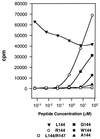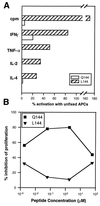Heteroclitic proliferative responses and changes in cytokine profile induced by altered peptides: implications for autoimmunity
- PMID: 9419364
- PMCID: PMC18196
- DOI: 10.1073/pnas.95.1.264
Heteroclitic proliferative responses and changes in cytokine profile induced by altered peptides: implications for autoimmunity
Abstract
Productive engagement of T cell receptors (TCRs) by cognate ligand (major histocompatibility complex plus peptide) leads to proliferation, differentiation, and the elaboration of effector functions. Altered peptides generated by single amino acid substitutions in the antigenic peptide have diverse effects on the outcome of the T cell response. We have generated an altered peptide (Q144) from an autoantigenic peptide of myelin proteolipid protein 139-151 by a single amino acid substitution (from tryptophan to glutamine) in the primary TCR contact at position 144 that is capable of inducing CD4(+) T cell responses in H-2(s) mice. By using a Q144-specific T cell clone (Q1.1B6), we see a hierarchy in T cell proliferation and cytokine production with various position 144 substituted peptides and have identified a peptide (L144) that hyperstimulates this T cell clone. In contrast to Q144, L144 induces maximal proliferation at 7 logs lower antigen concentration, induces greater cell death at higher antigen dose, and induces the secretion of cytokines not detected following stimulation with the cognate ligand. This heteroclitic T cell response associated with changes in cytokine profile was observed with several other T cell clones of different specificities. The L144 peptide also induces costimulation independent proliferation and cytokine production from the Q1.1B6 T cell clone. We describe this as a superagonist response. Such responses may have a role in the initiation of autoimmunity by promoting a proinflammatory environment following ligation of a cross-reactive TCR on autoreactive T cells.
Figures




Similar articles
-
Autoantigen-responsive T cell clones demonstrate unfocused TCR cross-reactivity toward multiple related ligands: implications for autoimmunity.Cell Immunol. 2000 Jun 15;202(2):88-96. doi: 10.1006/cimm.2000.1660. Cell Immunol. 2000. PMID: 10896768
-
Tuning T cell activation threshold and effector function with cross-reactive peptide ligands.Int Immunol. 2000 Feb;12(2):205-13. doi: 10.1093/intimm/12.2.205. Int Immunol. 2000. PMID: 10653856
-
T cell tolerance induced by cross-reactive TCR ligands can be broken by superagonist resulting in anti-inflammatory T cell cytokine production.J Immunol. 2005 Aug 1;175(3):1491-7. doi: 10.4049/jimmunol.175.3.1491. J Immunol. 2005. PMID: 16034086
-
Modification of human T-cell responses by altered peptide ligands: a new approach to antigen-specific modification.Intern Med. 1998 Oct;37(10):804-17. doi: 10.2169/internalmedicine.37.804. Intern Med. 1998. PMID: 9840700 Review.
-
Degenerate recognition and response of human CD4+ Th cell clones: implications for basic and applied immunology.Mol Immunol. 2004 Feb;40(14-15):1089-94. doi: 10.1016/j.molimm.2003.11.009. Mol Immunol. 2004. PMID: 15036913 Review.
Cited by
-
NFM Cross-Reactivity to MOG Does Not Expand a Critical Threshold Level of High-Affinity T Cells Necessary for Onset of Demyelinating Disease.J Immunol. 2017 Oct 15;199(8):2680-2691. doi: 10.4049/jimmunol.1700792. Epub 2017 Sep 8. J Immunol. 2017. PMID: 28887429 Free PMC article.
-
Reduced self-reactivity of an autoreactive T cell after activation with cross-reactive non-self-ligand.J Exp Med. 2002 Nov 4;196(9):1151-62. doi: 10.1084/jem.20020390. J Exp Med. 2002. PMID: 12417626 Free PMC article.
-
Manipulating antigenic ligand strength to selectively target myelin-reactive CD4+ T cells in EAE.J Neuroimmune Pharmacol. 2010 Jun;5(2):176-88. doi: 10.1007/s11481-009-9181-3. Epub 2009 Nov 11. J Neuroimmune Pharmacol. 2010. PMID: 19904613 Free PMC article. Review.
-
Human leucocyte antigen-A2 restricted and Mycobacterium tuberculosis 19-kDa antigen-specific CD8+ T-cell responses are oligoclonal and exhibit a T-cell cytotoxic type 2 response cytokine-secretion pattern.Immunology. 2001 Nov;104(3):278-88. doi: 10.1046/j.1365-2567.2001.01307.x. Immunology. 2001. PMID: 11722642 Free PMC article.
-
4-1BB ligand enhances tumor-specific immunity of poxvirus vaccines.Vaccine. 2006 Jun 5;24(23):4975-86. doi: 10.1016/j.vaccine.2006.03.042. Epub 2006 Mar 31. Vaccine. 2006. PMID: 16621183 Free PMC article.
References
-
- Paul W E, Seder R A. Cell. 1994;76:241–251. - PubMed
-
- Kuchroo V K, Martin C A, Greer J M, Ju S T, Sobel R A, Dorf M E. J Immunol. 1993;151:4371–4382. - PubMed
-
- Chen Y, Kuchroo V K, Inobe J, Hafler D A, Weiner H L. Science. 1994;265:1237–1240. - PubMed
-
- Khoruts A, Miller S D, Jenkins M K. J Immunol. 1995;155:5011–5017. - PubMed
-
- Kuchroo V K, Prabhu Das M, Brown J A, Ranger A M, Zamvil S S, Sobel R A, Weiner H L, Nabavi N, Glimcher L H. Cell. 1995;80:707–718. - PubMed
Publication types
MeSH terms
Substances
Associated data
- Actions
- Actions
Grants and funding
LinkOut - more resources
Full Text Sources
Other Literature Sources
Research Materials

